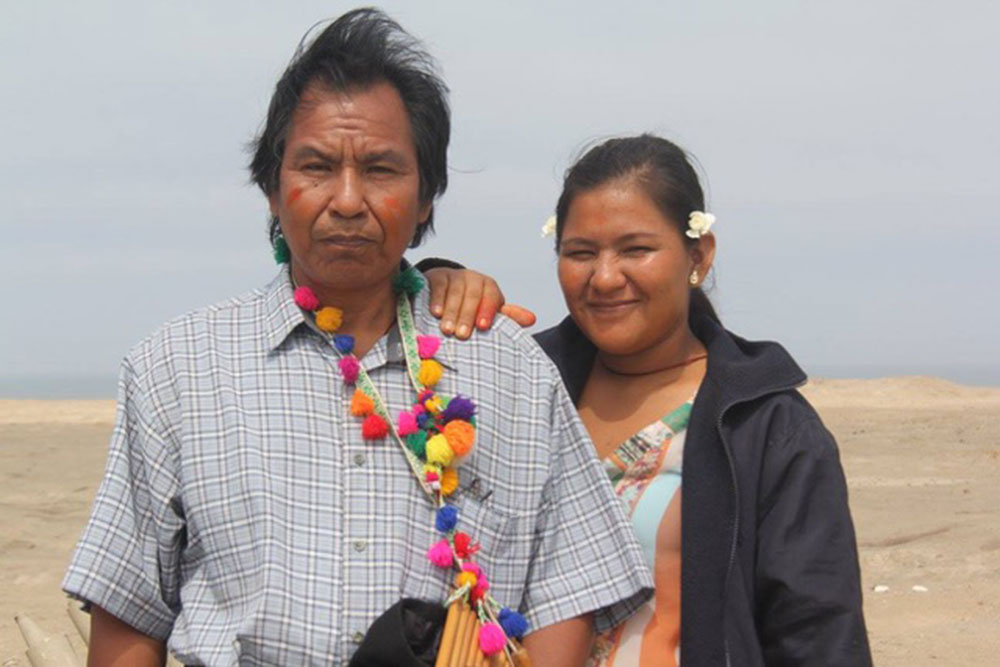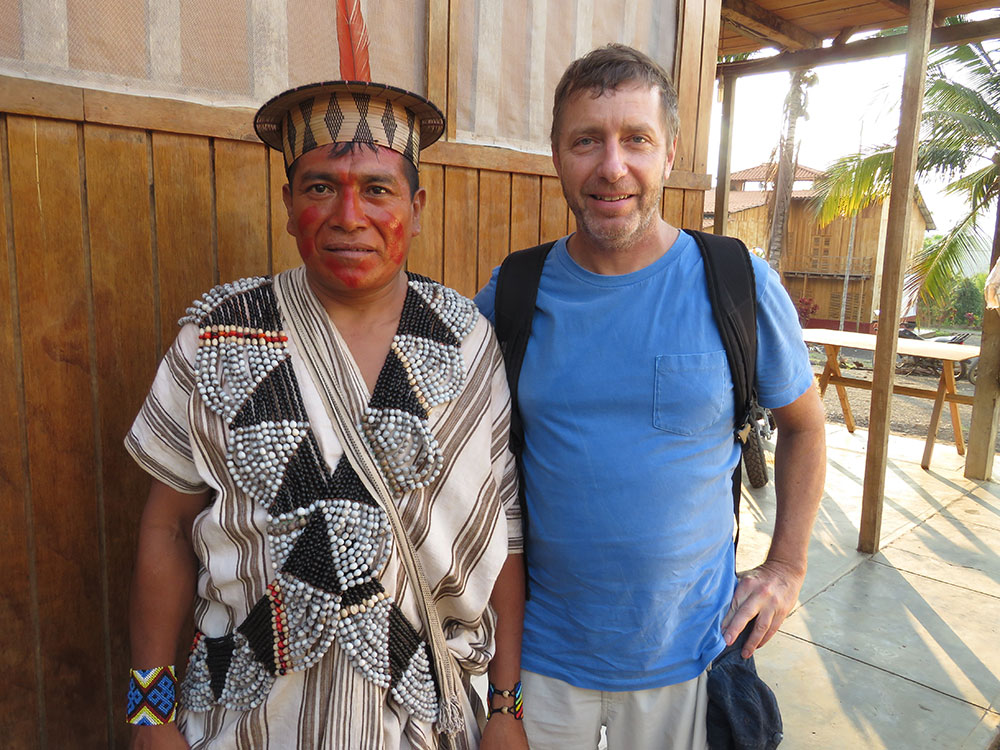Plant Teachers, Radical Social Distancing and Falling Skies: Interview with Jeremy Narby
Published 13 April 2021 by Rob La Frenais
Jeremy Narby, the worldwide-known author of ‘The Cosmic Serpent’ (1998) is releasing a new book this year, ‘Plant Teachers – Tobacco and Ayhuasca’. He was recently speaking in ‘The Incident’ online symposium. Interview.
26 years ago, when Swiss-Canadian author Jeremy Narby was preparing to publish his groundbreaking book on Ayhuasca and indigenous knowledge, ‘The Cosmic Serpent’ which would affect numerous researchers in this hitherto little-known field, I met him in Switzerland. After seeing an early draft, I invited him to take part in ‘The Incident’, two conferences, one happening in the context of the Belluard/Bollwerk Arts Festival in Fribourg in 1995 and the following year at the ICA, London, about mythologies surrounding UFOs and other unexplainable phenomena. Those conferences included figures like James Turrell, Jacques Vallee, Keiko Sei, the late Terence Mckenna, Roy Ascott, Michael Heim, Kristine Stiles, the late H R Giger, Ulrike Rosenbach, members of The Shamen and Rod Dickinson, with performances by Homer Flynn and The Residents, Linda Montano and Minnette Lehmann, Marko Peljhan, Erik Hobijn, Bruce Gilchrist, Ansuman Biswas and Anne Bean among others. Recently the artist Kathleen Rogers, who also took part, invited me to moderate an online symposium remembering ‘The Incident’ and I invited Narby to join us, on the eve of publishing his new book, ‘Plant Teachers – Tobacco and Ayhuasca’, before interviewing him for Makery. Narby is also Projects Coordinator for the Swiss NGO “Nouvelle Planète”, backing indigenous initiatives to bring land titling, bilingual education, health services, legal training and sustainable activities such as fish farming and forestry to indigenous communities.
Recording of “The Incident” video conference:
Makery: In the long period between ‘The Cosmic Serpent’ and ‘Plant Teachers – Tobacco and Ayhuasca’ things have changed a lot in the world of the Ashaninca peoples. What are the most important things you have observed in the world of your original collaborators?
Jeremy Narby: My original Ashaninca consultant, Carlos Perez Shuma, who introduced me in 1985 to the Ashaninca way of understanding the living rainforest, passed away in 2010, at the age of 70. So several of my original collaborators are no longer around. Their children are the adults in charge now. And the world they have to deal with increasingly involves oil companies, logging operations, mineral extractors, and so on. The industrial world’s hold on Ashaninca territory has grown relentlessly. But the Ashaninca remain strong people. Many continue to speak their mother tongue and have the will to move forward in the world. Nowadays, it’s hard to find an Ashaninca person who does not own a cell phone.
Since you published your book, people like Luis Eduardo Luna and Pablo Amaringo have become known in the contemporary art world. What has been, in your experience, the effect of this art from the Peruvian Amazon been on the world of the arts?
Luis Eduardo Luna, who is an anthropologist, and Pablo Amaringo, co-authored a book back in 1991, “Ayahuasca visions”, which changed how people thought about Amazonian shamanism. Amaringo’s paintings made visible this intense and powerful realm. This let the cat out of the bag, for all to see. It certainly sparked a broad interest in ayahuasca and in artistic representations of the visionary world the brew gives access to. Ayahuasca tends to stimulate creative people in many ways, and in particular how one does art, what art one does, and the reasons for doing it. Ayahuasca and art go together. And I would argue that ayahuasca and science also go together. With art, they would form a fine trio.
You talk about tobacco actually being a medicinal drug, flying in the face of received opinion about the dangers of cigarettes. Is it a question of the purity of the drug or is it a question of the way in which it is consumed?
It depends on the tobacco plants you grow, the fertiliser you put on them, the way you dry the leaves, the chemicals you add to them, and the way in which you consume it. For example, industrial cigarettes contain relatively weak tobacco, all sauced up in chemicals, which consumers tend to fire up 10 to 20 times a day, every day. This differs from strong shamanic tobacco, which is additive free, and which practitioners consume on precise occasions with clear intentions.
How did you ‘construct’ this new book with your collaborator Rafael Chanchari Pizuri? Do you think this collaboration challenges the viewpoint of the ‘Western’ anthropologist ‘studying’ indigenous cultures?

We dialogued first, then I did the transcribing and translating. We both wanted the indigenous view and the scientific view to be present and to be articulated in relation to each other. I wrote the scientific chapters in English, then translated them into Spanish so Rafael could read them and make comments. It really was a back and forth, an exchange between two systems of knowledge. But we did all this not because we wanted to challenge how anthropologists study indigenous cultures, but because we wanted to join forces and reach a richer understanding of two powerful South American plants that are used around the world.
In your new book you tell an anecdote about a shaman transforming into a jaguar. Then you say when you first tried pure tobacco paste you felt you grew feline whiskers and started to eye up the chickens as food, only deterred by being an anthropologist. Was this auto-suggestion or were you really being transformed by the drug?
Just what goes on in the brain-mind of an anthropologist who has swallowed some strong tobacco paste remains a mystery. Given nicotine’s impact on human hormones such as adrenaline, dopamine, endorphins, testosterone and oestrogen, and on the heartbeat, it seems clear that the strong and strange sensations that one can have at that moment are way beyond auto-suggestion. How one’s perception of oneself is affected by the substance remains to be studied.
In the same section on tobacco you say Acetylcholine is an “extremely old molecule”. Can you expand on this?
Some of the simplest living beings, including bacteria, unicells, algae and primitive plants, produce acetylcholine. And in complex beings such as ourselves, acetylcholine is implicated in numerous fundamental cellular activities, including setting up the production of other hormones. Acetylcholine is part of the basic cellular signalling system across the living world. We humans have receptors for it all over our body.
How has the spread of current (and future) pandemics been reflected in the worldview of indigenous knowledge systems?
Indigenous people have had a long and difficult experience dealing with pandemics. During the last 500 years, tens of millions of indigenous Americans died from contagious illnesses spread by their colonisers. ‘Un-contacted Indians’ are those indigenous Amazonians who decided to practice a radical form of social distancing: flee deep into the rainforest and keep a low profile for a long time. What’s more, they also practices “dietas” when they work with plants like ayahuasca and tobacco, and these “diets” imply not only abstaining from a whole range of foods, but from contact with other human beings. Amazonian cultures have the understanding that cultivating a distance from others is a way of enhancing one’s own perceptions. In numerous places across the Amazon, indigenous people have put this experience to practice in their response to the Covid pandemic. They have also closed off their territories to outsiders, wherever possible. However, it is also true that in some places, indigenous Amazonians have been severely affected by the pandemic and have not benefitted from medical support. As has become obvious, Brazil has turned into a Covid disaster area, and this has been to the detriment of most Brazilians, including indigenous Amazonians.
How might indigenous knowledge, Ayhuasca and Tobacco connect with open source technologies, DIY-bio, robotics, AI and other areas that might interest our readers?
The Amazonian approach to these plants is to consider them as teachers. People who ingest them can get knowledge, and gain insights and understandings about their current interests. Just how this works is still a question of debate. But the experience is verifiable by anyone who wants to take the risk.
I liked your analogy in the new book to being bilingual to the gap between indigenous and western science. Can you expand on this?

Science and indigenous knowledge are distinct ways of knowing the world. And a language, like English or French, is also a way of understanding the world and of naming it. Just like one can go back and forth between two languages, translating the concepts and words on the way, one can do the same with science and indigenous knowledge. Sometimes the concepts do not correspond, and cannot be translated, but this is also true with languages. And in all cases, practice makes perfect. Call it bi-cognitivism, by analogy to bilingualism: it is possible to carry around two ways of knowing in one’s mind, and to consider any question from one angle or the other. And to go back and forth between the two. Bilinguals have more fun! I wrote “Plant Teachers” in English, then translated it into French. It’s being published first in France because the French publishing house was on board from the start and wanted to publish the first version of the book. The book will also be published in Spanish, Portuguese and German within the next 12 months.
What things does the new book say which could not have been known when you wrote ‘The Cosmic Serpent’?
The science of Ayahuasca was only just being born in 1995. The science of tobacco had been around for longer, but still, science’s understanding of psychoactive substances has made giant leaps forward in the last 25 years. Just about everything in the book that concerns science could not have been known 25 years ago.
Finally can I ask you about the climate emergency? Could the systems of knowledge, or indeed entities encountered through Ayhuasca suggest a solution to potential human extinction caused by the West?
Ayahuasca has a knack for suggesting solutions to those who know how to ask pertinent questions. So my answer to your question is affirmative. That said, it might be worth reading the book “The Falling Sky” by Yanomami shaman Davi Kopenawa, co-authored with anthropologist Bruce Albert, to get an understanding of how indigenous Amazonians view the human extinction risk posed by the West. In brief, Kopenawa is not hopeful; he sees Westerners as “people of the merchandise”, so enamoured with their products and commodities that they are willing to extract nature to death for their own enrichment. And he sees no end to this folly. In his view, we are causing the sky to fall, hence the title of the book.
The French edition of ‘Plant Teachers – Tobacco and Ayhuasca’ has just been published.
The English edition will be published by New World Library in September 2021.
